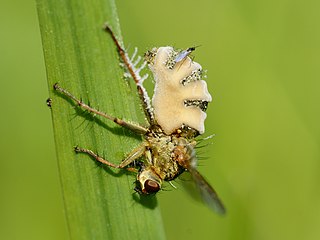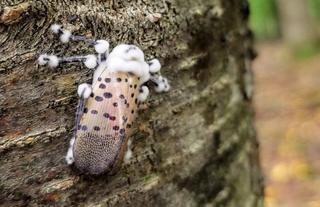Related Research Articles

Ascomycota is a phylum of the kingdom Fungi that, together with the Basidiomycota, forms the subkingdom Dikarya. Its members are commonly known as the sac fungi or ascomycetes. It is the largest phylum of Fungi, with over 64,000 species. The defining feature of this fungal group is the "ascus", a microscopic sexual structure in which nonmotile spores, called ascospores, are formed. However, some species of the Ascomycota are asexual, meaning that they do not have a sexual cycle and thus do not form asci or ascospores. Familiar examples of sac fungi include morels, truffles, brewers' and bakers' yeast, dead man's fingers, and cup fungi. The fungal symbionts in the majority of lichens such as Cladonia belong to the Ascomycota.

In biology, a spore is a unit of sexual or asexual reproduction that may be adapted for dispersal and for survival, often for extended periods of time, in unfavourable conditions. Spores form part of the life cycles of many plants, algae, fungi and protozoa.

Zygomycota, or zygote fungi, is a former division or phylum of the kingdom Fungi. The members are now part of two phyla: the Mucoromycota and Zoopagomycota. Approximately 1060 species are known. They are mostly terrestrial in habitat, living in soil or on decaying plant or animal material. Some are parasites of plants, insects, and small animals, while others form symbiotic relationships with plants. Zygomycete hyphae may be coenocytic, forming septa only where gametes are formed or to wall off dead hyphae. Zygomycota is no longer recognised as it was not believed to be truly monophyletic.

An entomopathogenic fungus is a fungus that can kill or seriously disable insects.

The Entomophthorales are an order of fungi that were previously classified in the class Zygomycetes. A new subdivision, Entomophthoromycotina, in 2007, was circumscribed for them.
Sporogenesis is the production of spores in biology. The term is also used to refer to the process of reproduction via spores. Reproductive spores were found to be formed in eukaryotic organisms, such as plants, algae and fungi, during their normal reproductive life cycle. Dormant spores are formed, for example by certain fungi and algae, primarily in response to unfavorable growing conditions. Most eukaryotic spores are haploid and form through cell division, though some types are diploid or dikaryons and form through cell fusion.

Nematophagous fungi are carnivorous fungi specialized in trapping and digesting nematodes. Around 160 species are known. There exist both species that live inside the nematodes from the beginning and others that catch them, mostly with glue traps or in rings, some of which constrict on contact. Some species possess both types of traps. Another technique is to stun the nematodes using toxins, which is a method employed by Coprinus comatus, Stropharia rugosoannulata, and the family Pleurotaceae. The habit of feeding on nematodes has arisen many times among fungi, as is demonstrated by the fact that nematophagous species are found in all major fungal groups. Nematophagous fungi can be useful in controlling those nematodes that eat crops. Purpureocillium, for example, can be used as a bio-nematicide.

The Pilobolaceae are a family of fungi in the Mucorales order. Generally, species in this family have a widespread distribution, although there are some that are restricted to tropical and subtropical regions. This family includes two genera: Pilobolus, and Utharomyces.

Entomophthora muscae is a species of pathogenic fungus in the order Entomophthorales which causes a fatal disease in flies. It can cause epizootic outbreaks of disease in houseflies and has been investigated as a potential biological control agent.

The Zoopagomycotina are a subdivision of the fungal division Zygomycota sensu lato. It contains 5 families and 20 genera. Relationships among and within subphyla of Zygomycota are poorly understood, and their monophyly remains in question, so they are sometimes referred to by the informal name zygomycetes.

The Ancylistaceae are a family of fungi in the order Entomophthorales. The family currently contains 3 genera: Ancylistes, Macrobiotophthora, Conidiobolus. Capillidium was added in 2020, it was once thought to be a sub-genus of Conidiobolus. Microconidiobolus and Neoconidiobolus were also added in 2020.
Conidial anastomosis tubes (CATs) are cells formed from the conidia of many filamentous fungi. These cells have a tubular shape and form an anastomosis (bridge) that allows fusion between conidia.
Zoophthora is a genus of fungi in the family Entomophthoraceae. Like other taxa in this family, Zoophthora species cause disease in insects and as such are considered entomopathogenic fungi.
Entomophaga grylli is a fungal pathogen which infects and kills grasshoppers. It is the causal agent of one of the most widespread diseases affecting grasshoppers. This is sometimes known as summit disease because infected insects climb to the upper part of a plant and grip the tip of the stem as they die; this ensures widespread dispersal of the fungal spores. The fungus is a species complex with several different pathotypes, each one of which seems to be host-specific to different subfamilies of grasshoppers. The pathogen is being investigated for its possible use in biological pest control of grasshoppers.
Arthrobotrys dactyloides is a species of fungus in the family Orbiliaceae. It is nematophagous, forming loops of hypha to trap nematodes, on which it then feeds.

Amoebophilus is a genus of zygomycete fungi that parasitizes amoeba.
Stylopage is a polytypic genus of predacious fungus in the order Zoopagales, within the subphylum Zoopagomycotina. All known species of Stylopage subsist on various species of amoebae or nematodes by trapping their prey, typically using an adhesive substance that coats their vegetative hyphae, and absorbing nutrients through the projection of a haustorium. 17 extant Stylopage species have been described thus far.

This glossary of mycology is a list of definitions of terms and concepts relevant to mycology, the study of fungi. Terms in common with other fields, if repeated here, generally focus on their mycology-specific meaning. Related terms can be found in glossary of biology and glossary of botany, among others. List of Latin and Greek words commonly used in systematic names and Botanical Latin may also be relevant, although some prefixes and suffixes very common in mycology are repeated here for clarity.

Furia is a genus of fungi within the family of Entomophthoraceae of the Zygomycota. This has been supported by molecular phylogenetic analysis.

Batkoa is a genus of fungi within the family of Entomophthoraceae and order Entomophthorales of the Zygomycota. This has been supported by molecular phylogenetic analysis.
References
- 1 2 3 C. Dreschler, 1940, "Three new hyphomycetes preying on free-living terricolous nematodes" Mycologia 32:448-470
- 1 2 3 4 5 6 7 "Meristacraceae | Zygomycetes". www.zygomycetes.org. Retrieved 4 January 2023.
- 1 2 3 4 P. F. Cannon and P. M. Kirk (Editors) Fungal Families of the World (2007) , p. 210, at Google Books
- 1 2 David J. McLaughlin and Joseph W. Spatafora (Editors) Systematics and Evolution: Part A (2014) , p. 223, at Google Books
- 1 2 Saikawa, Masatashi; Oguchi, Masami; Castañeda Ruiz, Rafael F (1997). "Electron microscopy of two nematode-destroying fungi, Meristacrum asterospermum and Zygnemomyces echinulatus (Meristacraceae, Entomophthorales)". Canadian Journal of Botany. 75 (5): 762–768. doi:10.1139/b97-086.
- ↑ Humber RA. "Synopsis of a revised classification for the Entomophthorales (Zygomycotina)". Mycotaxon. 34 (2): 441–60 (see p. 453).
- ↑ Saikawa, Masatoshi (February 2011). "Ultrastructure of the septum in Ballocephala verrucospora (Entomophthorales, Zygomycetes)". Canadian Journal of Botany. 67 (8): 2484–2488. doi:10.1139/b89-318.
- ↑ Humber, Richard A. (December 2012). "Identification of entomopathogenic fungi". Manual of Techniques in Invertebrate Pathology. Cornell University. pp. 151–187.
- 1 2 Carl A. Batt and Pradip Patel (Editors) Encyclopedia of Food Microbiology (2014) , p. 59, at Google Books
- ↑ Drechsler, Charles (1960). "Conidial Propulsion in Meristacrum Asterospermum". Sydowia. 14: 98–103.
- ↑ Davidson, J. G. N.; Barron, G. L. (January 2011). "Nematophagous fungi: Meristacrum". Canadian Journal of Botany. 51 (1): 231–233. doi:10.1139/b73-031.
- ↑ Frank Matthews Dugan The Identification of Fungi: An Illustrated Introduction with Keys, Glossary, and Guide to Literature (2006) , p. 19, at Google Books
- 1 2 3 4 D.H. Howard (Editor) Pathogenic Fungi in Humans and Animals (2002) , p. 130, at Google Books
- ↑ "Meristacrum - Search Page". www.speciesfungorum.org. Species Fungorum. Retrieved 4 January 2023.